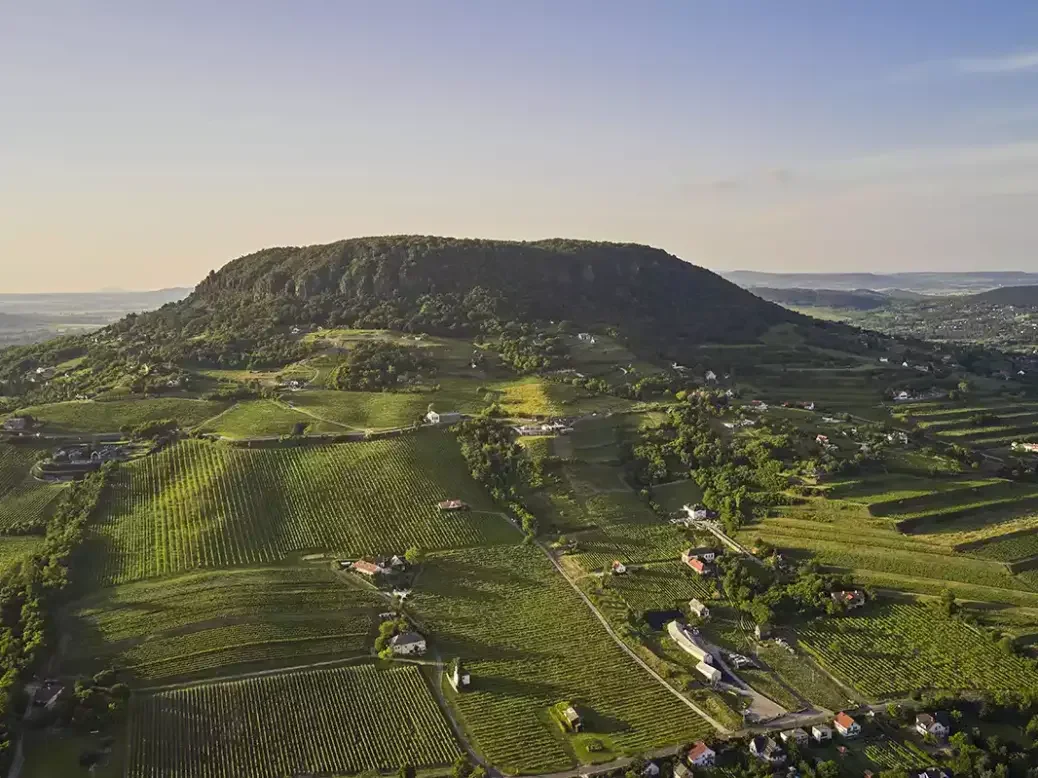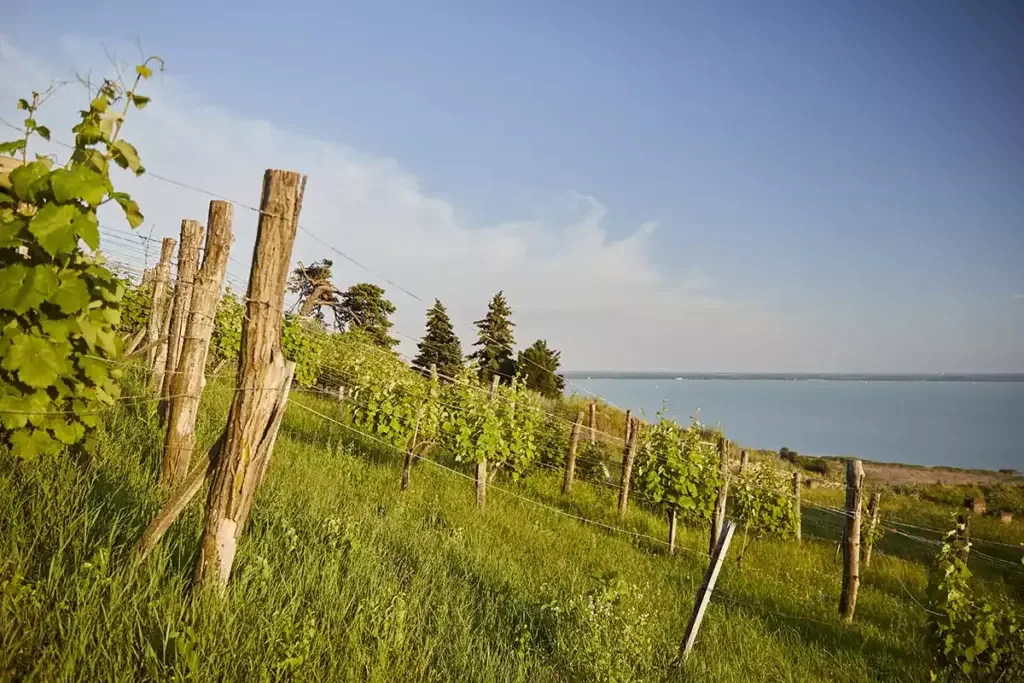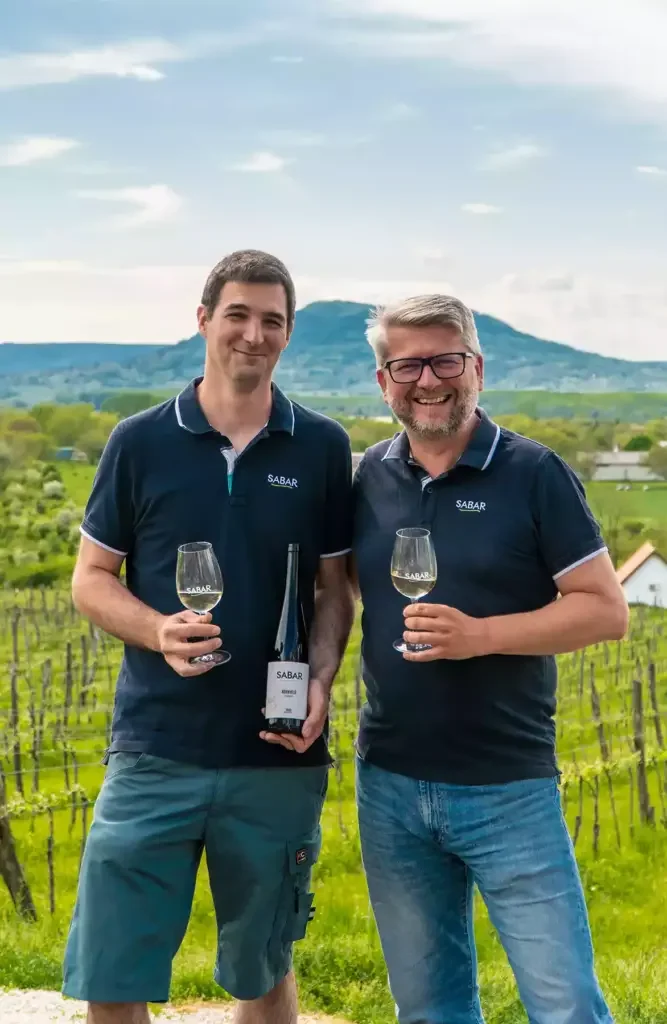
Sarah Marsh MW meets the growers and researchers who have rescued the Kéknyelű grape variety from near extinction in the Hungarian PDO of Badascony on Lake Balaton in Hungary and are now making some fascinating, ageworthy white wines.
Above us on a small terrace carved into the basalt rock of Badacsony-hegy huddle dwah arf bush vines of Kéknyelű. They are the oldest vines of this rare grape variety, which by the 1990s was almost extinct. Indeed, by then, there were just three parcels remaining: The 0.25ha (0.62 acres) parcel on Badacsony-hegy—an inactive volcano—was planted over a century ago on the south-facing slope that drops into the blue shallows of Lake Balaton; plus a further 0.1ha (0.25 acres) close by; and 0,6 ha at the western foot of Gulács Hegy. About 3,000 vines covering a total surface of less than one hectare (2.47 acres) in the PDO of Badacsony on the north shore of Lake Balaton.
My companion for the day was Bàlint Földi a winemaker and grower who wrote his university dissertation on Kéknyelű. He produces Kéknyelű from 0.1ha (0.25 acres) of vines on neighboring Szent György-hegy (St George’s Hill) and is among 30 people currently growing some Kéknyelű. With a current surface area of 45ha (111 acres), Kéknyelű has come back from the brink and is enjoying a quiet renaissance.
Kéknyelű’s surprising survival
It’s a wonder it survived at all for it is low yielding (0.5-1kg [1.1 to 2.2 pounds] per vine) and difficult to cultivate. “As far as we know,” says Bàlint “the first documentation dates from 1799 by Pál Kitaibel, a botanist and chemist, who mentioned Kéknyelű as the second most-planted variety in the region.” He goes on to explain, “Prior to 1850, all vineyards were mixed plantations. More than 40 varieties were planted on Badacsony Hill, however Kéknyelű was the second most widespread covering around 50ha (124 acres). From the 1850s, single-variety plantations increased rapidly with Kéknyelű becoming, from a quality perspective, one of the three most important varieties until just after WWII. It declined rapidly to just 5ha (12.4 acres) by the mid-1960s and 1ha (2.47 acres) around 1990.”
As Bàlint goes on to recount, “Kéknyelű was planted mainly in the vineyards of the nobility and the church. Being functionally female it is very prone to millerandage and in those times it was goblet-trained on stakes resulting in even lower yields. It needs the best vineyards with abundant water supply, good sun exposure, and warmth that are free from spring and fall frost, as it is very sensitive to droughts, but matures very late. And with very thick skins the volume of pressed juice is also small. That’s why everyday, mostly poor, growers couldn’t afford to cultivate it.”
As a single-sex variety it must be co-planted with another variety to pollinate it, usually Budai Zöld, sometimes Rózsakő, which must be harvested and made separately. Moreover Kéknyelű was planted with a labor-intensive density of 10,000 vines per hectare up to a seriously squashed 20,000 vines per hectare on the steep and narrow terraces. No wonder these vineyards were swept away in the Communist era, bulldozed in 1967 to make way for broad sweeping terraces planted on 4.5m (15ft) spacing to be workable by large tractors and meet the required yield of 6kg (13 pounds) per vine. This altered the soil profile, by bringing topsoil from above. Even the Research Institute of Wine and Oenology on Badacsony Hill was ordered to replant Kéknyelű with oranges.
It survived only because growers were allowed to keep 0.1ha (0.25 acres), but its struggle for survival continued. In 1986 it was almost polished off by a vicious frost. After which, just the three small parcels remained.
In 1991-93, after the regime changed, people began buying land and planting vines. At this time Huba Szeremley was drawn to Badacsony by memories of lakeside summers as a child before the family fled the country in 1967. He invested his fortune made in Africa as an engineer into land in Badacsony, piecing together over 100ha (247 acres), which included the 0.25ha of Kéknyelű on Badacsony hill. He was largely responsible for Kéknyelű’s revival.
If you’ve ever read about or attended a Kéknyelű tasting, it’s likely to have included Szeremeley’s Kéknyelű 2006, which has been doing the rounds for years. Still vibrant and fresh when I tasted it on this visit, it is a dependable ambassador for the variety. It certainly piqued my interest when I tasted it at the Gay Hussar restaurant in Soho a few years ago.
2006 was an excellent vintage, surpassed only by 1997 I am told. Szeremeley’s Kéknyelű 2006 has 7 g/l TA. This is 1–1.5 g/l higher than any other Kéknyelű I tasted on my visit and seems largely responsible for Kéknyelű’s reputation for longevity. From the tastings I made, ten years is a more reasonable expectation.

Young Kéknyelű
But I am jumping the gun. What is Kéknyelű like as a young wine? We can say the variety is very lightly aromatic with decent, but not high acidity and is medium bodied with modest alcohol. This does not sound exciting, but in combination with the terroir it comes alive. The attraction lies in its capacity to transmit the character of the soil and microclimate into a savory, firmly structured wine with slatey-mineral freshness.
As for the soil and climate, Kéknyelű is grown in the basalt soil of extinct volcanoes known locally as “witness hills.” The volcanic soil differs from the older andesite, rhyolite soils of Tokaj. Where the dark basalt is gravelly and flecked with little stones it is know as corn basalt. There is also some sandstone to the east and limestone to the west. There are 14 hills or “hegy” with vineyards planted within a 100–300m (330–980ft) belt. The tallest and most famous are Badacsony Hill (437m [1,434ft]) and Saint George Hill (415m [1,362ft]) at the top of which the basalt is fractured into vertical strata known as organ pipes. The charming landscape belies the hardship of the recent past for the forested hilltops conceal the scars left by the communist basalt quarries.
The basalt retains the daytime heat during the night so there is not a big diurnal swing here—10°C (18°F) to a maximum of 15°C (27°F). It can get very hot in July. Recent vintages have peaked at 35°C (95°F), 40°C (104°F) in 2022, but the water of Lake Balaton rarely exceeds 30°C (86°F) and is usually cooler, which ameliorates the conditions and provides cooling breezes and moistness to the air.
As you might expect Kéknyelű retains a little more acidity on the east and south-east facing slopes, but even those from the warmer south and south-west slopes tend to be quite trim and fresh. The acidity is enhanced by a sensation of minerality, in this case a slate and salt, silky-graphite impression. It has a rich texture which can become oily with bottle age.
Bàlint took me to the Research Institute of Wine and Oenology (MATE) located among the vineyards on Badacsony Hill to meet viticulturist Csaba Nemeth and winemaker Andreas Kollath. They have been unable to trace the ancestry of the Kéknyelű but speculate that it’s a mutation of an ancient variety Zöld Hajnos.
The Institute has developed three clones to address the problems of low yields and virus associated with Kéknyelű. (The total surface of Kéknyelű had reached 50 hectares in 2013 when the large producer Varga grubbed up twenty hectares of Kéknyelű suffering from virus.) Among the new clones B1 is higher yielding and can be cultivated on vertical trellising which has encouraged more planting, while B3 is sensitive to noble rot and can be used to make sweet wine. I tasted a MATE late-harvest Kéknyelű 2022 which the institute aged in barrel. This combined marmalade richness with just-sufficient freshness. In Kéknyelű’s heyday from 1855–1875 and in the 1930s, when it produced wines which were highly prized, Bàlint tells me “Kéknyelű—always late-harvested—was used to produce dry to off-dry wines, often semi-sweet and sometimes dessert wines.”
Csaba Nemeth explains that the soil is high in potassium which is responsible for the rather high pH—3.5+—of Badacsony’s wines. This accounts for Kéknyelű’s silkiness which evolves into a creamy (which the producers describe as oily) texture. In a colder vintage, a pH will typically be 3.3 and in a warmer one can reach 3.6. With pH this high most producers try to avoid malolactic.
Nemeth and Kollath prefer to make Kéknyelű’ in “a fresher, new-wave style” using cultured yeast, temperature control and no oak. “We experimented with oak, but it killed the aromas.” I tried their wine—MATE Kéknyelű’ 2023—which is quite floral with a silky (they say soapy) texture.
New Kéknyelű vineyards
Kéknyelű is never going to be widely planted, but it’s good to hear of a few new vineyards. In 2019 Vali Winery planted 2ha (5 acres), while Sike Balázs planted 0.7ha (1.7acres) in a south-west facing parcel. A tank sample of Sike Balázs 2023 was floral, light, and salty. And with new plantings we are likely to see more single-vineyard expressions in coming years. Bàlint, who consults for Sabar Winery among others, has planted a parcel on Gulács hill and a few rows on Badacsony hill for Pláne Borterasz, the local wine bar, which is a relaxed venue worth a visit if you’re interested in the local wines.
But some of the best sites on Badacsony Hill and Saint George Hill are under threat. Viticultural land with a lake view and a whiff of an opportunity to build changes hands for a princely €100,000 a hectare and new owners rarely bother with the accompanying vineyards.
But step back from the lake vista and land costs around €10,000 a hectare. The pristine pastoral landscape with its neat fields, luscious in their spring greenery when I visited, have attracted visitors and second homers from Budapest. Neat white houses, converted to home stays with “‘wine terraces,” reflect a flush era of wine tourism. Fortunately the newcomers include producers serious about wine and food, among them Gábor Ádám, who came in search of a bucolic lifestyle. He settled on Sabar-Hegy where he has planted 5ha (12 acres), most recently some Kéknyelű, in the sandstone soil beside his pretty guest house.
And here, kindly arranged by Gábor, I met with 13 Kéknyelű producers one spring day. They brought a recent vintage, a slightly older one, and plenty of enthusiasm. I enjoyed all the wines. I preferred some, but disliked none. Despite a pleasing variety of styles from different winemaking approaches, the wines shared light floral, herby, and citrus notes which became more honeyed with age. While on the palate the wines had slatey-salty minerality and a silky-satin texture. In other words a blend of terroir and grape variety formed the overarching impression.
Many showed the 2022 vintage, which was a dry hot vintage, and wines are on the richer and softer side. Bálint remarks: “Kéknyelű quickly loses its tartaric acidity in very dry vintages. It stops making sugar and feeds itself with tartaric acid, so you can have 16 brix (8.5% potential alcohol) at 5.5 TA.” Although there were some water reserves stored up in 2021, it feels as though this has happened since many 2022 wines had modest acidity. Where there was any wine left I tried it again the following day. Kéknyelű definitely benefits from time to open up since many of the 2022s improved the following day, so it’s a good idea to decant them.
The higher-yielding, warmer, but wetter 2023 had higher malic acidity and certainly seems fresher than 2022. I didn’t get to taste any 2021s which, together with 2020, was the coolest vintage in the past decade, but I really liked the 2020s. The 2017, which was a warm vintage although not as hot as 2022 and 2018, seems really rather vibrant. Clearly Kéknyelű improves with age, slimming down and refining, which is promising in light of recent hot summers.

What does Kéknyelű taste like?
And so to the wine. On one hand there is the camp of producers using a reductive stainless steel approach. These include Sike Balázs Winery. Their Kéknyelű 2020 has a savory graphite profile, which after 24 hours became more grippy and slatey. It was among my favorite wines of the tasting and comes from older vines on a steep south-facing slope on Badacsony Hill.
Éliás Winery also favor stainless steel for their classic Kéknyelű. 2020 was bright and citrusy, while Éliás ‘A Kő Marad’ 2022, which has one-third oak aging, was very quiet on opening, but much improved the second day when it showed a smooth-stone, channeled palate with rather good length and intensity.
The majority of producers age Kéknyelű in barrels of some description. Many use large 1,500-liter older oak foudres, although there seems to be a migration to 500l and some keep a part in stainless steel for freshness. Most avoid stirring so as not to encourage malolactic. Generally Kéknyelű is bottled after 6 months regardless of vessel.
The oak was low key on the wines. Only Sipos Kéknyelű 2022 was noticeably oaky. Borbély Kéknyelű wines, which are aged in very large old oak, were quite oxidative—a more “traditional” style maybe. Borbély 2022 had intriguing asphalt smokiness and fennel, quite nice, but it had faded the following day and the 2018 was really quite evolved.
Sabar Winery purchase must from Bobély, but the wines are very different. Sabar ferments and ages Kéknyelű for seven months in old 500l Stockinger. While most rely on cultured yeast this ferments spontaneously. If it doesn’t ferment out it’s left with some residual sugar and 4g/l was evident on the finish of Sabar’s 2022 Kéknyelű, but well balanced by salinity. (Bàlint is the winemaker here).
Sabar’s more energetic 2020 has bitter, sweet and savory miso notes. Quite a rich, glossy style, but attractive, while Edvi Illés Kéknyelű A Teraszról 2020, which took several months to ferment with indigenous yeast in older oak, is richly nutty and savory.
Bàlint of course makes his own wine. Just a 300l barrel. He doesn’t get much fruit from his small parcel located just under the tree line on Saint George’s Hill which has cooler south east facing exposure. Foldi Bàlint Kéknyelű 2022 was very restrained on opening, but silky-sleek and slatey after 24 hours while 2020 was expressive, showing savory, salty nuttiness with a creamy mid palate and a fresh finish. Very youthful and well balanced.
There is a third group experimenting with skin contact, MLF, and bâtonnage among them Váli Winery. I liked Váli Péter Ágyús dűlő 2022 a punchy, savory, and slightly funky 2022. There was even a bottle-fermented Kéknyelű. Eliás Brut Nature 2021 has a rose petal aroma and the spicy and sapid palate is not autolytic, but terroir- and varietal-driven.
Kéknyelű evolves beneficially in bottle. The producers agreed it needs four, but probably nearer six years, to develop its characteristic honeyed notes. Istvándi Kéknyelű 2019 already had a wildflower honey character, while the 2017 showed honey, orange, and bitter almond notes. Salty and vibrant, it is refining with age. It was rich, but appealingly sapid to finish. I really liked this and Válibor 2017 (magnum) which was both honeyed and zesty. From the warm 2018 vintage Laposa Kéknyelű had developed brioche and honey-hay notes.
Certainly Kéknyelű becomes more interesting as it develops tertiary characteristics which include honey with a hint of burnt orange peel. The light floral and almond notes evolve into richer buttery fennel. The palate fills out and the texture becomes more waxy.
There seems to be anxiety among some producers to pin down a style for Badacsony Kéknyelű, but I think they shouldn’t box themselves in. There is scope for different approaches. What is important is the terroir. If they focus on making wine to express their terroir, Kéknyelű may possibly recapture the prestige it enjoyed in the 19th century, albeit as a niche market curiosity.






